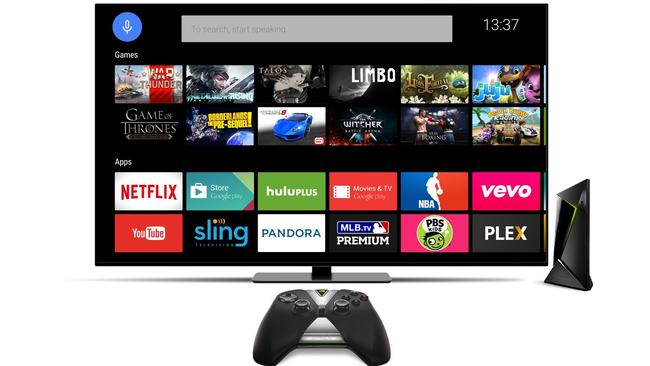Review: Nvidia Shield sets TV standard but Apple rules software
The fourth generation Apple TV and the Nvidia Shield powered by Android TV are two serious set top contenders.

The fourth-generation Apple TV and the Nvidia Shield powered by Google’s Android TV platform are two capable set-top boxes vying to play a central role in living rooms.
The Shield is by far the most technologically advanced set-top box on the market and, while Australians will need to import one from online retailers such as Amazon at $US199, it’s about the same price as the $269 Apple TV, based on current exchange rates. But which one is worth your cash?
Hardware
The Apple TV retains the same hockey puck design of its predecessor, but the box itself is a little taller to accommodate the upgraded internals, including 2GB of RAM, 32GB/64GB internal storage options and Apple’s snappy A8 dual-core processor.
The Shield is a striking mix of sharp angles and lines complemented by an alternating glossy and matt-black finish. The rectangular slab is a little wider than the Apple TV but packs some serious silicon. A Tegra X1 processor with a 256-core Maxwell GPU and an eight-core 64-bit ARM CPU combined with 3GB of super-fast DDR4 RAM gives the Shield real grunt, which translates into a fast and stutter-free software experience. Apps and menus load without delay and there’s no buffering.
The Shield also excels with its selection of ports, which include HDMI 2.0 capable of playing 4K content at up to 60fps, Gigabit ethernet, two USB 3.0 ports for connecting accessories like external USB drives and a micro-SD card slot. Both can be used to expand the 16GB of on-board storage. It also supports Logitech’s range of Harmony universal revotes via the IR receiver on the front. There’s also a remote and a game controller in the box.
The great thing about the Shield and the open nature of Android TV is the ability to connect virtually any USB or Bluetooth-enabled keyboard, mouse or game controller.
The Apple TV is limited to a HDMI 1.4 port, which means no 4K video and there’s no option to expand the internal storage either. It doesn’t come with a game controller but the Siri remote does boast a touchpad and motion controls that work across all of the games available on the App Store with varying degrees of success. Serious gamers will need to purchase an Apple-certified third-party gamepad.
Android TV vs tvOS
At the centre of both platforms is voice search and a store front where you can expand your entertainment options.
Both the Play store and the App Store support universal purchases so if you bought the app on your smartphone or tablet then you can download the big-screen version for free.
Apple’s App Store has a greater selection, including catch-up services from all the major networks and on-demand streaming content. Android TV natively supports Netflix, YouTube and Presto, but you’ll have to beam other services from your smartphone using the built-in Chromecast feature. It’s worth mentioning that some of the native apps available on Android TV aren’t as full-featured or polished as the Apple TV versions.
The Shield is the best place to experience Netflix and YouTube thanks to its ability to play back 4K content at 60fps. Its support for HDR means you can watch Netflix content with an expanded range of contrast and colour. Apple’s App Store offers extend beyond entertainment such as booking rental accommodations with Airbnb, personal training with Zova or shopping from the couch with Gilt.
The next version of Android TV (Android N) will bring a few notable features to the table that will benefit Shield owners, most importantly recording of live TV with in-app DVR functionality and picture-in-picture.
Gaming
The Apple TV’s gaming library offers a broad selection of titles but these are mostly large-scale versions of iPhone and iPad apps. You’ll find most of the popular mobile titles on the Shield as well.
However, Nvidia has partnered with several game studios to bring more advanced titles. This means that popular titles from the last generation of consoles such as Tales from Borderlands and Metal Gear Rising are all available.
The Shield is also fully armed and operational for in-home game streaming from your PC so you can play the latest titles on your living room television without the hassle of having to physically move your gaming rig from your desk.
Provided both your PC and Nvidia Shield are connected to your home network via a wired connection, the results are impressive.
Verdict
Nvidia’s sleek black box is easily the best Android TV device on the market and the most future-proof option with support for 4K at 60fps and HDR content. It also offers a superior gaming experience.
At roughly the same price as the new Apple TV ($US199/$276), the Shield offers a great deal of power but the software isn’t quite as polished as Apple’s and there’s not as much local streaming content available.
That said, if you want to get the most out of your 4K television and desire a powerful media player capable of playing anything you throw at it, the Shield is hands down the best option on the market.


